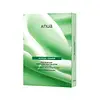What's inside
What's inside
 Key Ingredients
Key Ingredients

 Benefits
Benefits

 Concerns
Concerns

 Ingredients Side-by-side
Ingredients Side-by-side

Water
Skin ConditioningDipropylene Glycol
HumectantGlycerin
HumectantCetyl Ethylhexanoate
EmollientHydroxyacetophenone
AntioxidantCaprylyl Glycol
EmollientDipotassium Glycyrrhizate
Humectant1,2-Hexanediol
Skin ConditioningSodium Hyaluronate
HumectantHydrogenated Vegetable Oil
EmollientLecithin
EmollientPolyglyceryl-3 Methylglucose Distearate
EmulsifyingCetearyl Alcohol
EmollientGlyceryl Stearate
EmollientHouttuynia Cordata Flower/Leaf/Stem Water
AntimicrobialCarbomer
Emulsion StabilisingArginine
MaskingEthylhexylglycerin
Skin ConditioningTocopherol
AntioxidantSodium Phytate
Panthenol
Skin ConditioningButyrospermum Parkii Butter
Skin ConditioningCeramide NP
Skin ConditioningPhytosphingosine
Skin ConditioningWater, Dipropylene Glycol, Glycerin, Cetyl Ethylhexanoate, Hydroxyacetophenone, Caprylyl Glycol, Dipotassium Glycyrrhizate, 1,2-Hexanediol, Sodium Hyaluronate, Hydrogenated Vegetable Oil, Lecithin, Polyglyceryl-3 Methylglucose Distearate, Cetearyl Alcohol, Glyceryl Stearate, Houttuynia Cordata Flower/Leaf/Stem Water, Carbomer, Arginine, Ethylhexylglycerin, Tocopherol, Sodium Phytate, Panthenol, Butyrospermum Parkii Butter, Ceramide NP, Phytosphingosine
Water
Skin ConditioningNiacinamide
SmoothingPropanediol
SolventDipropylene Glycol
Humectant1,2-Hexanediol
Skin ConditioningHydroxyacetophenone
AntioxidantTrehalose
HumectantGlycerin
HumectantSodium Acrylic Acid/Ma Copolymer
Butylene Glycol
HumectantDisodium EDTA
Carbomer
Emulsion StabilisingArginine
MaskingOctyldodeceth-16
EmulsifyingXanthan Gum
EmulsifyingCaprylyl Glycol
EmollientGlycine
BufferingGlutamic Acid
HumectantCentella Asiatica Extract
CleansingMadecassoside
AntioxidantAspartic Acid
MaskingAnthemis Nobilis Flower Extract
MaskingPortulaca Oleracea Extract
Skin ConditioningGluconolactone
Skin ConditioningSodium Polyacrylate
AbsorbentSodium Chloride
MaskingResveratrol
AntioxidantCentella Asiatica Flower/Leaf/Stem Extract
Skin ConditioningCentella Asiatica Leaf Extract
Skin ConditioningCentella Asiatica Root Extract
Skin ConditioningSaccharomyces Ferment
Skin ConditioningHistidine
HumectantSerine
MaskingAlanine
MaskingThreonine
Proline
Skin ConditioningAcrylates/C10-30 Alkyl Acrylate Crosspolymer
Emulsion StabilisingAsiaticoside
AntioxidantMagnesium Chloride
Calcium Chloride
AstringentAloe Barbadensis Leaf Juice
Skin ConditioningAsiatic Acid
Skin ConditioningMadecassic Acid
Skin ConditioningParfum
MaskingWater, Niacinamide, Propanediol, Dipropylene Glycol, 1,2-Hexanediol, Hydroxyacetophenone, Trehalose, Glycerin, Sodium Acrylic Acid/Ma Copolymer, Butylene Glycol, Disodium EDTA, Carbomer, Arginine, Octyldodeceth-16, Xanthan Gum, Caprylyl Glycol, Glycine, Glutamic Acid, Centella Asiatica Extract, Madecassoside, Aspartic Acid, Anthemis Nobilis Flower Extract, Portulaca Oleracea Extract, Gluconolactone, Sodium Polyacrylate, Sodium Chloride, Resveratrol, Centella Asiatica Flower/Leaf/Stem Extract, Centella Asiatica Leaf Extract, Centella Asiatica Root Extract, Saccharomyces Ferment, Histidine, Serine, Alanine, Threonine, Proline, Acrylates/C10-30 Alkyl Acrylate Crosspolymer, Asiaticoside, Magnesium Chloride, Calcium Chloride, Aloe Barbadensis Leaf Juice, Asiatic Acid, Madecassic Acid, Parfum
 Reviews
Reviews

Ingredients Explained
These ingredients are found in both products.
Ingredients higher up in an ingredient list are typically present in a larger amount.
1,2-Hexanediol is a synthetic liquid and another multi-functional powerhouse.
It is a:
- Humectant, drawing moisture into the skin
- Emollient, helping to soften skin
- Solvent, dispersing and stabilizing formulas
- Preservative booster, enhancing the antimicrobial activity of other preservatives
Arginine is an amino acid that is important for human development. Your body uses is it to produce hair keratin and skin collagen.
As a cosmetic ingredient, Arginine has antioxidant properties and can also help repair damaged skin. This ingredient is derived either synthetically or from animals.
Arginine isn't fungal acne safe when used in the presence of other lipids (fats, fatty acids, oils, esters, etc). Oils and fats occur naturally within the skin, so take caution when using Arginine if you're prone to fungal acne.
Learn more about ArginineCaprylyl Glycol is a humectant and emollient, meaning it attracts and preserves moisture.
It is a common ingredient in many products, especially those designed to hydrate skin. The primary benefits are retaining moisture, skin softening, and promoting a healthy skin barrier.
Though Caprylyl Glycol is an alcohol derived from fatty acids, it is not the kind that can dry out skin.
This ingredient is also used as a preservative to extend the life of products. It has slight antimicrobial properties.
Learn more about Caprylyl GlycolCarbomer is a polymer of acrylic acid. Its main role is to create a gel consistency.
A high amount of carbomer can cause pilling or balling up of products. Don't worry, most products contain 1% or less of carbomer.
Dipropylene Glycol is a synthetically created humectant, stabilizer, and solvent.
This ingredient helps:
Dipropylene glycol is technically an alcohol, but it belongs to the glycol family (often considered part of the ‘good’ alcohols). This means it is hydrating and gentle on skin unlike drying solvent alcohols like denatured alcohol.
As a masking agent, Dipropylene Glycol can be used to cover the smell of other ingredients. However, it does not have a scent.
Studies show Dipropylene Glycol is considered safe to use in skincare.
Learn more about Dipropylene GlycolGlycerin is already naturally found in your skin. It helps moisturize and protect your skin.
A study from 2016 found glycerin to be more effective as a humectant than AHAs and hyaluronic acid.
As a humectant, it helps the skin stay hydrated by pulling moisture to your skin. The low molecular weight of glycerin allows it to pull moisture into the deeper layers of your skin.
Hydrated skin improves your skin barrier; Your skin barrier helps protect against irritants and bacteria.
Glycerin has also been found to have antimicrobial and antiviral properties. Due to these properties, glycerin is often used in wound and burn treatments.
In cosmetics, glycerin is usually derived from plants such as soybean or palm. However, it can also be sourced from animals, such as tallow or animal fat.
This ingredient is organic, colorless, odorless, and non-toxic.
Glycerin is the name for this ingredient in American English. British English uses Glycerol/Glycerine.
Learn more about GlycerinHydroxyacetophenone is antioxidant with skin conditioning and soothing properties. It also boosts the efficiency of preservatives.
This ingredient is not irritating or sensitizing.
Water. It's the most common cosmetic ingredient of all. You'll usually see it at the top of ingredient lists, meaning that it makes up the largest part of the product.
So why is it so popular? Water most often acts as a solvent - this means that it helps dissolve other ingredients into the formulation.
You'll also recognize water as that liquid we all need to stay alive. If you see this, drink a glass of water. Stay hydrated!
Learn more about Water